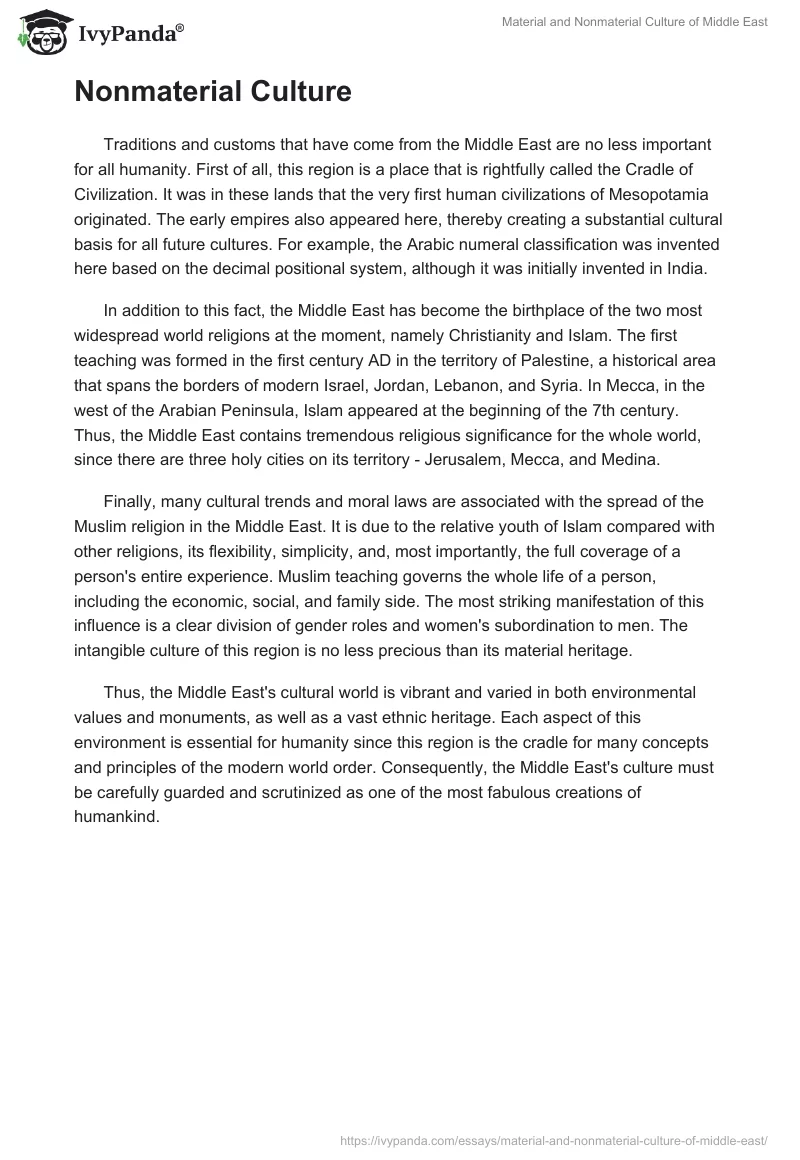Imagine stepping into a bustling marketplace in Morocco. The air is thick with the scent of spices, vibrant colors burst from stalls overflowing with textiles, and the melodic calls of vendors weave through the crowd. This sensory experience is immediately captivating, but it’s only one layer of the rich cultural tapestry that exists there. Beneath the visible surface lies a complex web of beliefs, values, and traditions that shape the lives of the people and the very fabric of their society. This intricate web, invisible yet powerful, is what we call nonmaterial culture.

Image: ivypanda.com
Understanding nonmaterial culture is crucial for navigating our increasingly interconnected world. It helps us bridge cultural gaps, foster empathy, and appreciate the diverse ways people make sense of the world. In this article, we’ll delve deeper into the concept of nonmaterial culture, exploring its components, its role in shaping human behavior, and its influence on our everyday lives.
Defining Nonmaterial Culture
While material culture encompasses the tangible objects we create and use – like clothing, tools, and technology – nonmaterial culture refers to the intangible aspects of a society. It encompasses the ideas, beliefs, values, and norms that influence how people think, behave, and interact with the world around them.
Key Components of Nonmaterial Culture:
- Beliefs: These are fundamental convictions about the world. They can range from religious faiths to scientific theories to personal philosophies. For example, a belief in karma influences how people act in Hinduism, while the scientific belief in evolution informs our understanding of the natural world.
- Values: Values represent what a society considers desirable, good, or important. They guide the way people prioritize their lives and make decisions. For instance, valuing individual freedom leads to different societal structures than valuing collective well-being.
- Norms: Norms are unwritten rules that dictate appropriate behavior in different situations. These guidelines can range from informal social expectations, like politeness, to formal laws. Violating norms can result in social disapproval, sanctions, or even legal consequences.
- Language: More than just a means of communication, language serves as a powerful tool for transmitting culture. It shapes our understanding of the world, influences our thought processes, and binds us together through shared meanings and expressions.
- Symbols: Symbols are objects, gestures, or signs that represent something beyond their literal meaning. They can convey complex ideas, emotions, or cultural values. Flags, religious icons, and even emojis are examples of symbols that hold significant meaning within specific cultural contexts.
The Impact of Nonmaterial Culture
Nonmaterial culture plays a critical role in shaping our lives in numerous ways. It influences our:

Image: www.livingbyexample.org
1. Identity:
Nonmaterial culture contributes significantly to our sense of self and belonging. It provides frameworks for understanding our place in the world, and our role within our families, communities, and societies.
2. Behavior:
The beliefs, values, and norms embedded in our culture shape our actions – from simple everyday choices to complex decisions about careers, relationships, and social interactions.
3. Perspectives:
Nonmaterial culture filters how we perceive and interpret the world around us. It frames our understanding of events, our reactions to situations, and our acceptance of other cultures.
Examples of Nonmaterial Culture
Nonmaterial culture manifests itself in countless ways. Here are some specific examples:
1. Religious Practices:
Religions are powerful examples of nonmaterial culture. They shape the beliefs, values, and norms of their followers, influencing their daily lives, ethical codes, and even political systems.
2. Artistic Expressions:
Art forms, from painting and music to film and literature, are laden with cultural meaning. They reflect the values, beliefs, and even anxieties of their creators and audiences.
3. Holidays and Festivals:
Yearly celebrations, like Christmas, Diwali, or Ramadan, are ingrained in many cultures. They commemorate key events, perpetuate shared beliefs and traditions, and bring people together.
4. Etiquette and Customs:
The way we greet each other, address authority figures, or interact in social settings are all influenced by cultural norms. These unspoken rules ensure smooth social interactions within a specific community.
Cultural Differences and Intercultural Communication
The diversity of nonmaterial cultures across the globe creates a fascinating tapestry of human experiences. However, it also presents challenges in understanding and communicating across different cultures.
1. Cultural Relativism vs. Ethnocentrism:
Cultural Relativism encourages us to understand practices from the perspective of the culture in which they exist, avoiding judgment based on our own cultural norms. Ethnocentrism, on the other hand, involves judging other cultures based on the standards of one’s own culture, often leading to bias and misunderstandings.
2. Intercultural Communication:
Successful intercultural communication requires an understanding of the different values, beliefs, and communication styles that shape each culture. It involves active listening, empathy, and a willingness to learn from others.
Which Of The Following Is An Example Of Nonmaterial Culture
The Power of Nonmaterial Culture
Despite its intangible nature, nonmaterial culture exerts a profound influence on our lives and societies. It shapes our identity, guides our behavior, and frames our perceptions of the world.
By understanding the nuances of different cultural systems, we can foster empathy, bridge divides, and appreciate the rich tapestry of human experiences that make our planet so fascinating and diverse.






